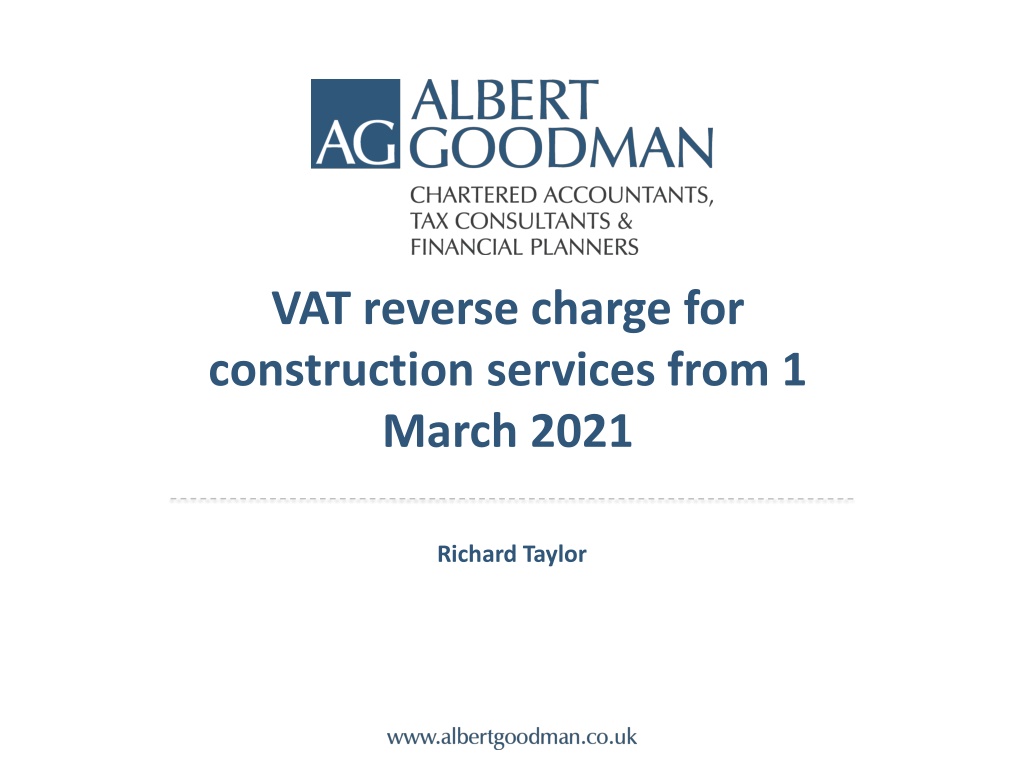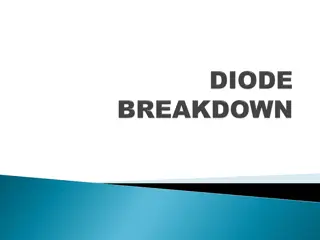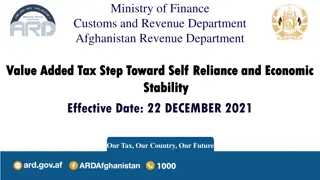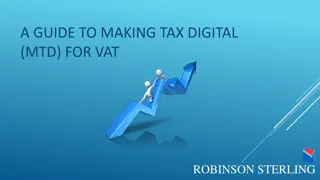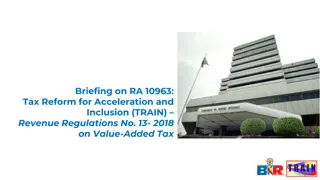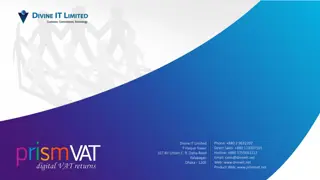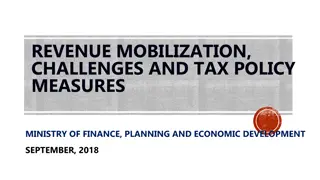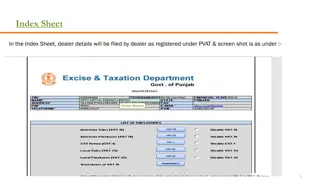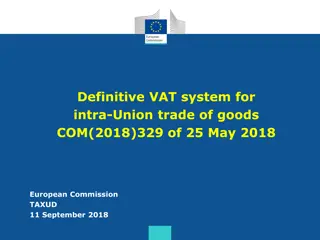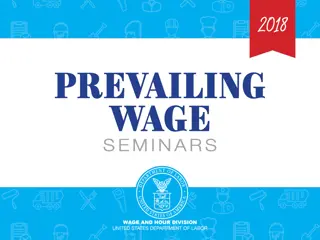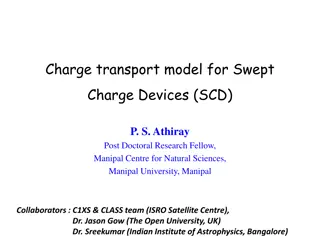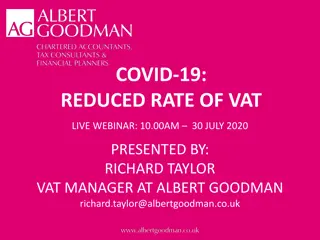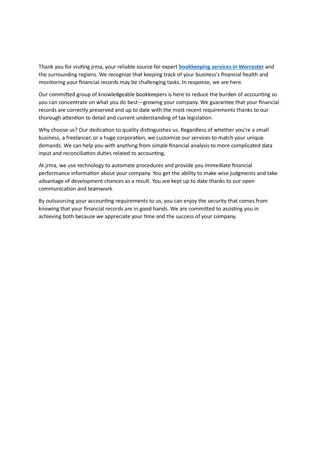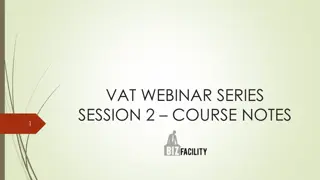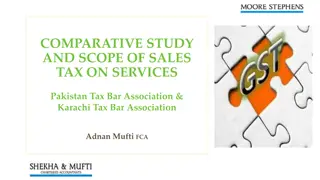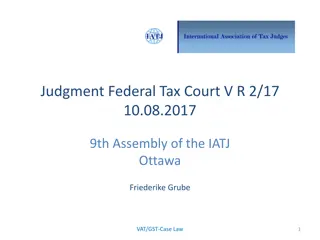Understanding VAT Reverse Charge for Construction Services
Overview of VAT reverse charge for construction services effective from 1st March 2021, covered areas, how it works, services covered & not covered, and specifics on labor-only construction services eligible for reverse charge. Details on invoicing, accounting, and transitional arrangements, with examples and illustrations.
Download Presentation

Please find below an Image/Link to download the presentation.
The content on the website is provided AS IS for your information and personal use only. It may not be sold, licensed, or shared on other websites without obtaining consent from the author. Download presentation by click this link. If you encounter any issues during the download, it is possible that the publisher has removed the file from their server.
E N D
Presentation Transcript
VAT reverse charge for construction services from 1 March 2021 Richard Taylor
Areas to be covered Overview Services covered by Reverse Charge Deciding if the Reverse Charge applies and examples Simplifications and areas to be aware of Invoicing including examples Transitional arrangements Accounting Sage & Xero
How does it work VAT payments End User Reverse Charge Currently End User VAT of X VAT of X VAT of X Recipient of construction services (not end user) Recipient of construction services (not end user) VAT of X VAT of X Supplier of construction services Supplier of construction services
What services are covered Services that fall within the scope of CIS, including: constructing, altering, repairing or demolishing buildings or structures constructing, altering, repairing or demolishing any works forming, or to form, part of the land, including, e.g. walls, roads, civil engineering works Installing heating, lighting, air-conditioning or similar systems in a building or structure internal cleaning of buildings and structures if part of construction, alteration or repair work internal or external painting or decorating of buildings or structures Services which are integral to the services listed above including site clearance, earth-moving, laying of foundations, erection of scaffolding, site restoration, landscaping etc
What services that are not covered: Services of professionals such as architects Supplies of staff rather than construction services , e.g. by employment businesses key here is who has control over the workers and is responsible for work carried out Legislation does list various other works not covered, including installing: seating, blinds, shutters, security systems, burglar alarms, closed circuit television and public address systems artistic works such as sculptures Zero-rated services Supplies of goods only e.g. purchases from builders merchants
Labour only construction services These are covered by the new reverse charge and have the following features: Customer engages a business to carry out specified work labourers are employed by or engaged by the supplying business supplying business provides a price for the works or agrees a measured rate per square metre supplying business is responsible for the labourer s works and is responsible for correcting any defects following completion of the works customer, or its representatives, agrees that the work has been carried out or certifies payment for the value of works carried out to date
Services supplied by employment businesses (supplies of staff) These are not covered by the reverse charge and have the following features: the customer contacts the employment business and asks for X workers for Y days the workers are employed by or engaged by the employment business the employment business provides an hourly or daily rate for the workers a timesheet is used to record the hours and days worked the customer sends the signed timesheet agreeing the hours and days worked to the employment business the customer pays the employment business the customer s site foreman or managers direct and control the works carried out by the workers the customer is responsible for the works carried out
VAT reverse charge for construction services End Users End User a recipient of specified services who does not make an onward supply of the building and construction services supplied to them. Developers selling new buildings would be end-users as they are not resupplying the construction services but are selling buildings. Main contractors constructing buildings for the developer are not end-users as they would resupply construction services they receive as part of their charge for construction services to the developer. Intermediary supplier (relevant intermediary) connected to an end user, either by being in the same corporate group or by having a shared interest in the land, e.g. for example, landlord and tenant, where the works are taking place, and will make an onward supply of the construction services to the end user without material alteration or further processing.
End users confirmation Has to be in writing, this can be: On paper Electronically in an email In a contract which is signed or has been agreed in writing The notification has to show what supplies are covered, e.g. by mentioning site or a quote etc As an example: We refer to your quote dated 10/04/21 for alteration works to 123 Main Street, Taunton. We are an end user for the purposes of section 55A VAT Act 1994 reverse charge for building and construction services. Please issue us with a normal VAT invoice with VAT charged at the appropriate rate. We will not account for the reverse charge If you often deal with end users your Terms & Conditions can say you ll assume that your customer is an end user or intermediary supplier unless they say they re not
VAT and CIS registered supplier of services Ask customer if they are VAT registered Issue your normal invoice No Ask customer if they are CIS registered Issue your normal invoice No Decide if VAT would normally be charged on the work Issue your normal invoice No Issue standard VAT invoice Does work fall within CIS No Ask customer if they are an end user or relevant intermediary Yes Issue Reverse charge invoice No Issue standard VAT invoice
VAT and CIS registered recipient of services Reverse charge not applicable, normal invoices should be issued by supplier Decide if the work would attract VAT No Reverse charge not applicable, normal invoices should be issued by supplier Check if supplier is VAT & CIS registered No Reverse charge not applicable, normal VAT invoices should be issued by supplier Decide if the work is covered by CIS No You should receive a reverse charge invoice without a VAT charge from your supplier Decide if you are an end user No Yes Tell your supplier and they should issue a normal VAT invoice
Examples of how Reverse charge works Reverse charge applies Sub-contractor issues reverse charge invoice for 50,000 Customer VAT regd Y Customer CIS regd Y VAT chargeable on work Y Is service reported in CIS - Y Customer end user -N VAT and CIS registered sub-contract roofer Subbie does work of 50,000 for main contactor on shop VAT & CIS registered main contractor Reverse charge does not apply Main contractor invoices retailer for 500,00 plus 100,000 VAT Customer VAT regd Y Customer CIS regd Y VAT chargeable on work Y Is service reported in CIS -Y Customer end user -Y Main contractor contacts with retailer to build shop for 500,000 Retail company who will occupy shop retailer is end user
Examples of how Reverse charge works Where work of 50,000 is done on main contactors own head office Customer VAT regd Y Customer CIS regd Y VAT chargeable on work Y Is service reported in CIS -Y Customer end user Y VAT and CIS registered sub contract roofer Reverse charge does not apply Sub-contractor issues VAT invoice for 50,000 plus 10,000 VAT (VAT value declared in box 1 of VAT return and net value in box 6 of VAT return) VAT & CIS registered main contractor not making onward supply of roofing Main contractor is end user as they are not making an onward supply of the roofing services
Simplifications If a supply has a reverse charge element exceeding 5% of total value the whole supply will be subject to the domestic reverse charge If the reverse charge element is 5% or less it can be ignored Where there has already been a reverse charge service between two parties on a construction site they can agree that any subsequent construction supplies between them on that site are also treated as reverse charge services If there is doubt whether work falls within the definition of a specified service, as long as the recipient is VAT registered and the payments are subject to CIS, the reverse charge should apply
Specific circumstances to be aware of Supply and fix if provided at same time and on same site reverse charge applies to both (subject to 5% test) Separate contracts for labour & materials - if provided at same time and on same site reverse charge applies to both Where goods not ordinarily incorporated into new house are supplied and installed in new build housing the reverse charge does not apply Where goods not ordinarily incorporated into new house are supplied and installed as part of a residential conversion or refurbishment the reverse charge does apply Scaffolding hire & erection etc is within CIS and reverse charge when standard rated. For new build houses reverse charge applies to hire (S/R) but not erection/dismantling (Z/R) when separately charged
Reverse charge invoices Reverse charge invoice must show Sequential number Date of issue Name, address & VAT number of supplier Name & address of customer e.g. main contractor Description of services provided The value of work at different VAT rates VAT rate applicable VAT amount due on reverse charge (not compulsory) The total amount payable A statement that the reverse charge applies
Transition/Cut off Invoices Where VAT invoices have been issued the following applies: Invoice issued before 1 March 2021 use normal VAT rules Invoice issued on or after 1 March 2021 apply reverse charge rules For self billed invoices or authenticated receipts Where payments are due on supplies entered into your accounting system before 1 March 2021, but paid on or after 1 March 2021 the following applies: Date entered into accounting system Date payment made VAT treatment Before 1 March 2021 On or before 31 May 21 Normal rules Before 1 March 2021 On or after 1 June 21 Reverse charge On or after 1 March 2021 On or after 1 March 21 Reverse charge
Things to consider Sub-contractors may be in a repayment situation so monthly returns may be beneficial Cash Accounting does not apply to reverse charge invoices they should be declared on the VAT return based on payment date Reverse charge supplies are excluded from the Flat Rate Scheme this may have an impact as VAT will not be reclaimable of costs associated with making reverse charge supplies
Accounting system entries - Sage How will it work: 1. Tax codes - New tax codes have been created T21 to be used where CIS Reverse Charge Standard Rate applies. T26 to be used where CIS Reverse Charge Reduced Rate applies 2. Above codes are used for both sales and purchase invoices 3. You only need to enter net amount (Sage will automatically calculate the VAT for the return) 4. Subcontractor - When a subcontractor uses tax code T21 or T26 on sales invoice for their main contractor: Box 6 of the VAT Return, total value of sales excluding VAT, will be updated with the net amount of the sale. There is no impact on boxes 1 and 4 of the VAT Return (i.e. no VAT to pay or reclaim)
Accounting system entries - Sage How will it work: 5. Contractor - When a main contractor uses T21 or T26 to record their purchase from the subcontractor: the net value of the purchase affects box 7 of the VAT the VAT value affects boxes 1 and 4 of the VAT Return The VAT is paid and reclaimed on the same VAT Return and therefore has a neutral impact. 6. Invoices and credit notes - if the T21 or T26 tax code is used, then the invoice or credit note produced includes Invoice text - 'Customer to pay output tax of X to HMRC Credit note text - 'Customer to account for output tax of - X to HMRC This is if you create invoices within the Sage module.
Accounting system entries - Sage Useful links Version 26 and onwards has changes built in Sage guidance - https://gb- kb.sage.com/portal/app/portlets/results/viewsolution.jsp?solutionid=200427 112546520&page=1&position=1&q=reverse%20charge%20cis
Accounting system entries - Xero How will it work: 1. Similar to Sage, Xero will have the core function built in.
VAT reverse charge for construction services Useful links To check VAT numbers https://www.gov.uk/check-uk-vat-number To check CIS registration https://www.gov.uk/use-construction-industry-scheme-online HMRC General Guidance https://www.gov.uk/guidance/vat-domestic-reverse-charge-for-building-and- construction-services HMRC Technical Guide https://www.gov.uk/guidance/vat-reverse-charge-technical-guide#
Richard Taylor richard.taylor@albertgoodman.co.uk 01823 286 096 TAUNTON BRIDGWATER BURNHAM-ON-SEA CHARD WEDMORE WESTON-SUPER-MARE WEYMOUTH YEOVIL
TAUNTON CHARD WEDMORE WESTON-SUPER-MARE WEYMOUTH YEOVIL
